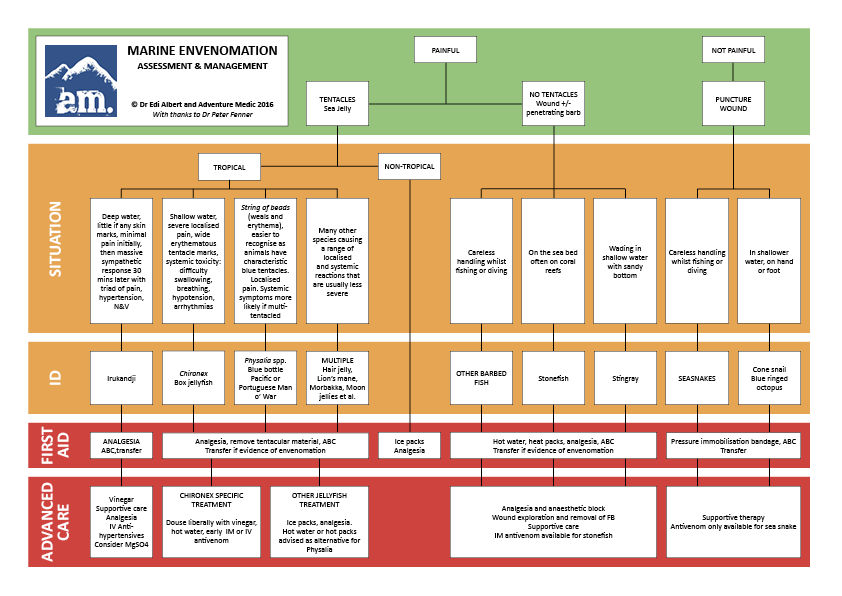Dr Edi Albert / Royal Flying Doctor Service
As summer is round the corner in the Northern Hemisphere, we turn our attentions to all the bitey, stingy things that live in the sea. We are proud to present the Adventure Medic Guide to Marine Envenomation, courtesy of Dr Edi Albert. Nautical gold.
When I was eight years old we went on a family holiday to Majorca. As a lad growing up in Liverpool where the local waters looked like they had flowed straight out of Mordor, it was an amazing experience to splash around in the warm blue sea of the Mediterranean: until something slippery slithered past my leg and I screamed so loudly that even my usually hydrophobic mother rushed in to help. No doubt I was being overly dramatic. It probably wasn’t a sea snake that had relocated to cooler climes, nor a sea jelly (the taxonomists tell us not call them jellyfish – because they are Cnidarians and not fish at all), but probably just a bit of seaweed suspended in the water column and moving at the whim of the currents. The story has a happy ending: there were no marks on my legs, I did not suffer a cardiac arrest, and fortunately have become rather tougher and more stoic as an adult.
The point of the story is that more often than not, when somebody suffers an insult in the water we do not know what caused the problem. Sometimes we can make a pretty good guess based on geographical location and the context of the injury. Of course, it is sometimes evident what caused the injury: a sea snake caught in a fishing net, a cone shell picked up by someone unaware as to its potential, or an accidental brush with the spines of a sea urchin. But, given that this topic is not well covered at medical school, even knowing what did it might not help much.
It is quite possible to provide first aid care without knowing what creature caused the insult. Let’s face it, most of us aren’t marine biologists. If you want to provide care beyond first aid though, you will need to be reasonably certain about what type of animal did the dirty. With some prior preparation before your trip and our downloadable Marine Envenomation Flowchart, you can have a pretty good stab at that too.
Back to Basics
Before we dive headlong into the nitty gritty, let’s define the scope of this article and go back to basics to re-visit some toxinological concepts and definitions.
This article is about marine envenomations that may be experienced in an expedition context or may be seen in GP / ED settings in regions where these animals are endemic. It does not cover common nuisances such as swimmers itch, surfer’s ear or skin infections occurring in a marine context. Nor does it cover ciguatera and scromboid poisoning; though you will need to think about all of these before heading off on your dream trip to paradise. Oh, and then there are the sharks – just make sure you’re not the slowest swimmer in the group, or wear a pink and green wetsuit so you don’t look like a seal. Always works for me, although I get funny looks putting my wetsuit on at the beach.
What is the difference between poisoning and envenomation? Or between a toxin and a poison?
Toxinology is the study of toxins, in a restricted sense, with reference to the relatively unstable proteinaceous substances of microbial, plant, or animal origins.
Poisons are substances that disrupt the body’s normal functioning. Toxins are naturally occurring poisons. Venom is a toxin that is deliberately injected into by one animal into another. Venom is a cocktail of proteins, predominantly enzymes, which cause havoc by multiple means. The contents of the venom vary between species. Havoc is usually wreaked on one or more of the nervous system, coagulation, muscle, and the heart. Anti-venom can be used to combat envenomation, however, it doesn’t always help and serum sickness (the body’s immunological response to a foreign protein) can be a real problem.
Remember it is the patient that we are treating, not the venom or the animal. A thorough initial assessment of the patient, with regular reviews, to determine whether the patient is systemically well or not, and whether the patient has specific signs of envenomation or not, is essential.
It may also help to understand that venom potency is related to the temperature of the environment. Thus, marine envenomations outside of tropical waters are rarely significant. For example, whilst a Bluebottle sting in southern Queensland may be very unpleasant indeed, the same animal down in Tasmanian waters is unlikely to disrupt your activities too much.
Planning
Before you go, try to consider the following:
Pre-trip planning / What lives where you are going? How do they behave? What might they do to you?
Contacts / In the event of an incident, and where you will be providing ongoing care, make sure you already have the phone number of a toxinologist who is familiar with the region in which you are travelling. In Australasia the Poisons Information Centre Australia (13 11 26) is your one-stop shop.
Now let’s consider what to do when an envenomation occurs.
From First Aid to Advanced Care
How do we provide first aid treatment if we don’t know what did it?
When you look at the conventional medical texts and first aid books, the content is arranged by the animal implicated with specific treatments described accordingly. This isn’t particularly helpful when you don’t deal with this stuff very often. Especially when you don’t have an encyclopaedic knowledge of marine species and little idea as to what might have caused the problem. A different approach is needed.
Some years ago I stumbled upon Peter Fenner’s Marine Medic website. Peter is a doctor in Mackay, Queensland, and although now retired, he has an international reputation in this field of marine envenomation and co-authored the wonderfully worthwhile and amazingly illustrated Venomous and Poisonous Marine Animals: a Medical and Biological Handbook. His website contains a lot of interesting information, but the icing on the cake is a simple flow diagram that guides management based on a few simple clinical criteria.
I have adapted and extended his flow chart to include advanced care. Download it as a free PDF, then laminate it and put it up on your yacht or in with your dive gear.

Pain
The first thing is to determine whether the original injury was painful or painless. Perhaps surprisingly, some of the deadliest things are painless.
The Painless Puncture Wound
A painless puncture wound can be caused by cone shells, sea snakes and blue ringed octopus, and whilst the circumstances of the injury may point to the culprit, all you need to know to start with is that the patient has painless puncture wound, and if in an endemic area for these creatures, then pressure immobilisation bandages (elastic NOT crepe) should be applied in the same way that you would for a snake bite. It is important to immobilise the limb, not just wrap it up. This is most certainly a patient you will keep a very close eye on and attempt to evacuate. It is also one of the few pre-hospital presentations in which prolonged CPR in the event of an arrest is worthwhile.
The painful wound
The first thing to figure out here is whether there are any tentacles adherent to the skin that would suggest a jellyfish sting. The painful wound without tentacles adherent will be likely to have a barb in it – which may be broken off inside the wound. The context of the injury will help you figure out the culprit, but irrespective of that, hot water or heat packs are indicated to neutralise the toxin and relieve pain.
When it comes to jellyfish, Chironex (Chironex fleckeri or commonly known as the “box jelly”) and Irukandji (Carukia barnsi) are the two nasties that always get the attention as they can be deadly, but there are other species capable inflicting misery. First aid and ongoing management is species dependent and is covered in the flow chart.
A Case
Let’s test out this approach using the flowchart with a clinical case.
You are on a dive trip somewhere nice and warm, and heading back to camp located at the back of a shallow bay. Ahead of you is another dive boat. There is a lot of commotion going on and a man is hopping on one leg, yelling and hanging on to the boat for balance.
By the time you get there five minutes later he is sitting on the beach. His foot is very painful and looks like the one in the picture below.
What is your immediate management? / This is a painful puncture wound and should be treated with hot water to denature the toxin.
You help him hobble back to the campsite. However, there is no electricity and only a modest first aid kit.
How might you practically administer his treatment? / Heat water on the camping stoves, mix it with cold water, do the “elbow test” and partly fill a dry bag in which to place the foot. The hot water can be topped up at regular intervals.
When we looked after this case for real, we also administered liberal quantities of fine tawny port to the whole group to maintain morale. His pain subsided quite quickly and the foot was left bathed in hot water for a couple of hours. No symptoms or signs of systemic envenomation occurred. The patient continued with his dive trip and the swelling settled over the next few days.
Given the location and circumstances of the injury, can we hypothesise what animal caused it? / This injury occurred in warm waters to a man wading in a shallow, sandy bottomed bay. This suggests a stingray injury, as stingrays often settle half hidden under the sand in shallow water. A stonefish injury is less likely, but if in the right region within the realms of possibility. However, one might expect that the pain would not be well controlled with just hot water and that the patient would show systemic signs of envenomation and require evacuation.
Keep Swimming
Remember, all articles on this subject, including this one, tend to focus on the nasty stuff. The reality is that most bites and stings cause only self-limiting inconvenience and can be treated quite simply. So keep playing in the sea!
Useful resources
Apps
Australian Bites and Stings App (Android / Apple: Free on App Store)
FOAMEd
Clinical Toxinology Resources from the University of Adelaide
Berling I, Ibister G. Marine Envenomations. Australian Family Physician, 2015. 44(1); 28-32
Perkins RA, Morgan SS.Poisoning, Envenomation, and Trauma from Marine Creatures. Am Fam Physician. 2004 Feb 15;69(4):885-890. This article provides a good overview with an American focus.
Lionfish and Stonefish Envenomation
Books
Warrell DA. Risks from animals. Ch17 in Johnson C et al (eds) Oxford Handbook of Expedition Medicine. Oxford: OUP; 2015.
White J. A Clinician’s Guide to Australian Venomous Bites and Stings. Parkeville: CSL Laboratories; 2013.
Williamson JA, Fenner PJ, Burnett JW, Rifkin JF (eds). Venomous & Poisonous Marine Animals. Sydney: UNSW Press; 1996.
A big thanks to Dr Bill Nimorakiotakis, Emergency & Retrieval Physician, and Clinical Toxinologist for reviewing this article. Cover image: Blue Ringed Octopus (Zain Fimmel)







